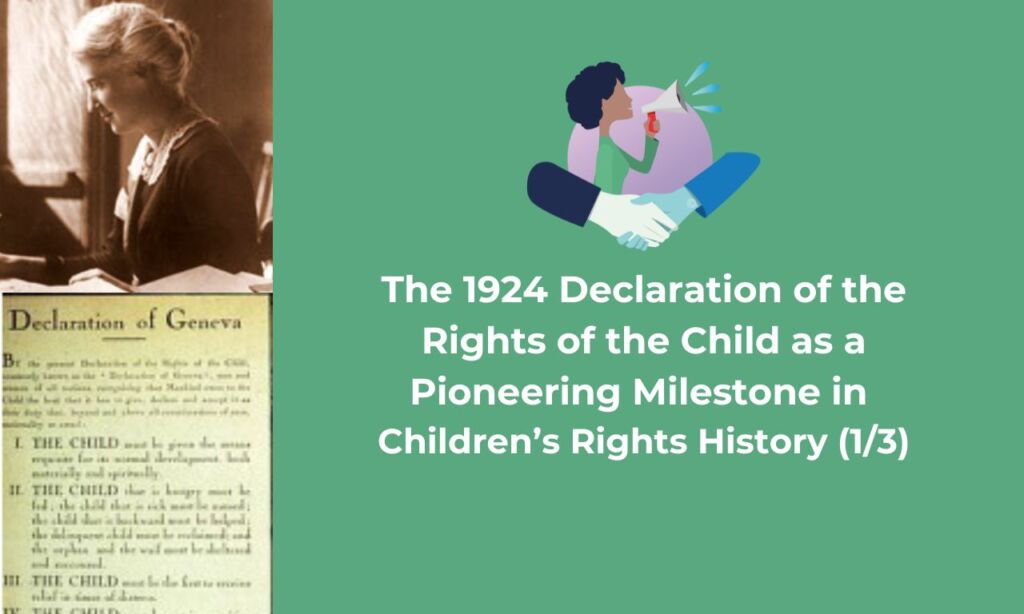
Embark on a three-part journey delving into the history of the international rights of the child.
- Written by: Apolline Foedit, PhD student in International History, the Graduate Institute, Geneva
- Pioneer advocacy
Part 1: The 1924 Declaration of the Rights of the Child as a Pioneering Milestone in Children’s Rights History.
The history of the 1924 League of Nations’ Declaration of the Right of the Child lies at the intersection of social reforms and humanitarian aid, cooperation and harsh rivalries between the emerging international institutions and transnational movements pioneering the rights of the child.
Since the end of the 19th century, reformist movements addressed the dire conditions of children in the fields of labour, anti-trafficking, justice, and education and promoted social and legal measures to improve them. To this end, the Bruxelles based Association Internationale pour la protection de l’enfance (AIPE) was created in 1913 to gather information and to provide technical expertise to both governments and private organizations.
WWI worsened the conditions of children across Europe – they were displaced, sick, hungry, and in need of assistance. To this end, many associations saw the light, one of them being Save the Children Fund (SCF), established by British reformers Dorothy Buxton and Eglantyne Jebb. In 1920, thanks to the collaboration of the International Committee of the Red Cross, the SCF helped create the Geneva-based Save the Children International Union (SCIU).
The establishment of the League of Nations in 1919, the first intergovernmental organization charged to promote peace and cooperation in the world, offered an arena for the many institutions interested in international child protection, including the AIPE and the UISE, to interact and, at times, to compete. In 1924, the Committee for the Protection of Children (CPE) was created by the League of Nations: a consultative institution, which was the participation of both governments and private organizations. The CPE collected information and facilitated the evolution of national legislations. In 1924, the CPE also adopted the Declaration of the Rights of the Child, formulated the previous year by the SCIU.
The Declaration summarised the fundamental needs of children in five points, recognising their specific rights to material and spiritual development, assistance, relief in times of distress, protection from exploitation in the workplace, and support to put talents for the common good. The creation of the CPE and the Geneva Declaration were pivotal moments both for the history of childhood and for the history of international relations.
The year 1924 was equally important in the history of the ISS, which became an independent organization, charged to relieve family ties broken by distance by means of inter-country casework, an innovative practice which paid attention to the migrant’s social, legal, and psychological environment and which the organization pioneered.
Join us as we delve further into the evolving landscape of children’s rights. In the next article, we will learn about the 1959 Declaration of the rights of the child. Stay tuned for more!
For more readings:
Baughan, Emilie. Saving the Children: Humanitarianism, Internationalism and the British Empire, 1915-1970. Berkeley, C.A.: University of California Press, 2020.
Droux, Joëlle. « L’internationalisation de la protection de l’enfance : acteurs, concurrences et projets transnationaux (1900-1925) », Critique internationale, vol. 52, no. 3, 2011, pp. 17-33.
Guerry, Linda. « Mobilisations transnationales. Le cas de l’International Migration Service, 1921-1939 », Monde(s), n°5, mai 2014, p. 219-237.
Guillemot-Treffainguy, Vanessa. La protection de l’enfant contre ses parents : (1804-1958). Thèse de doctorat en Histoire du droit. Sous la direction de Yann Delbrel. Bordeaux. 2017.
Marshall, Dominique. “The construction of children as an object of international relations: The Declaration of Childrens Rights and the Child Welfare Committee of League of Nations, 1900-1924”. The International Journal of Childrens Rights, 7, 103-147.9, 1999.